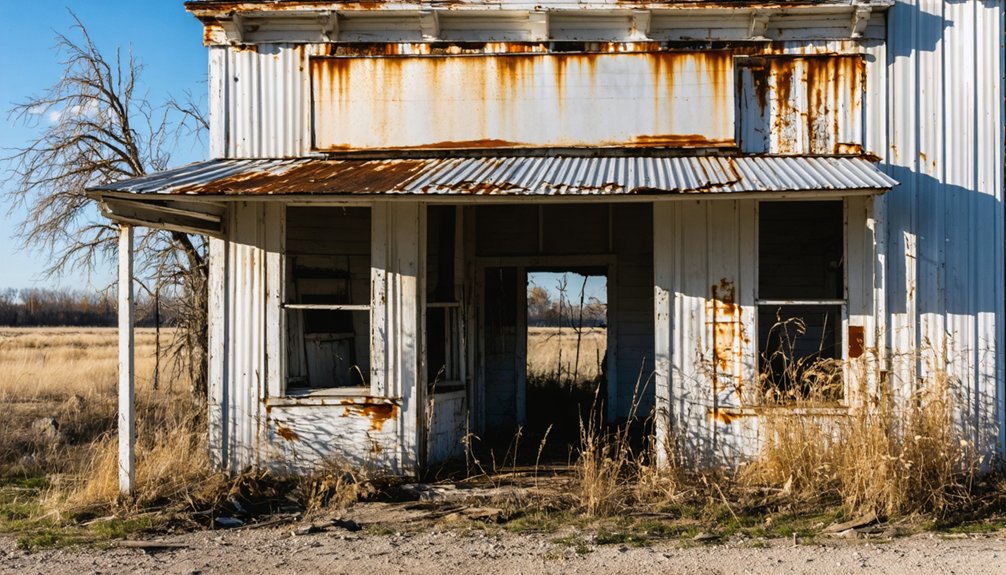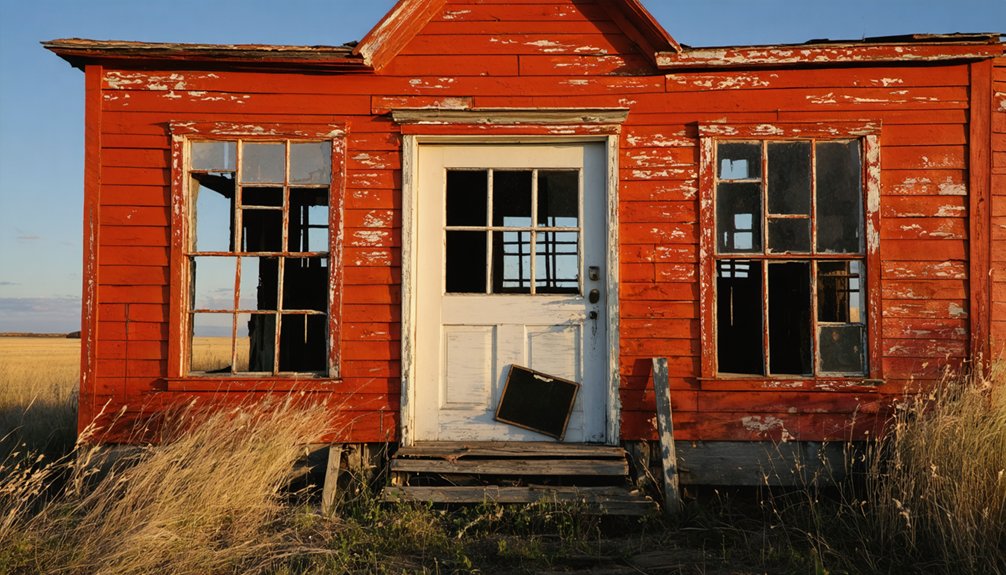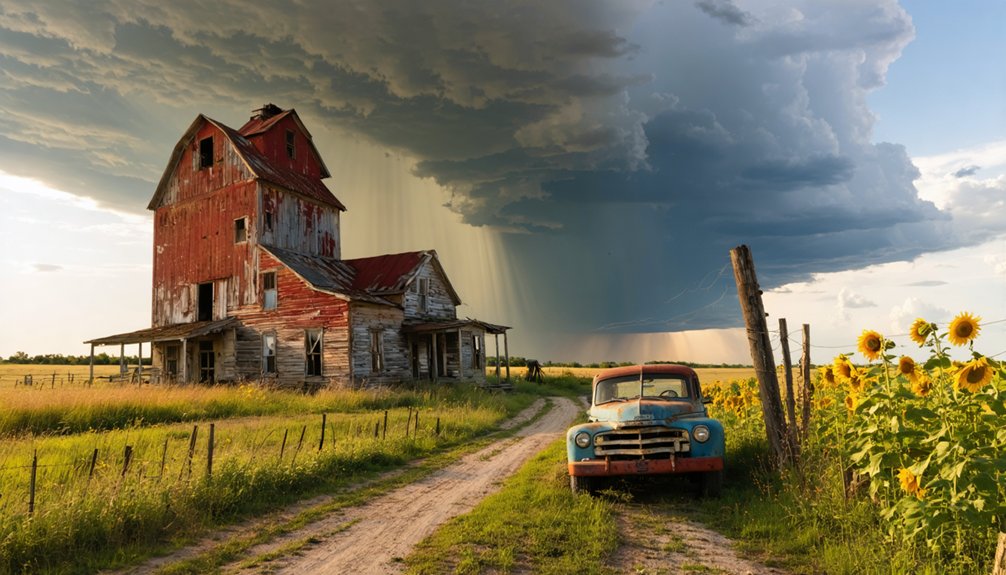You’ll find the haunting remnants of Lentz nestled in Lawrence County’s historic Black Hills mining country. This once-bustling frontier settlement thrived on agriculture and railroad commerce until natural disasters, economic hardship, and population decline led to its abandonment. Today, weathered structures, rusted farm equipment, and old railroad hardware dot the isolated landscape. Local tales of unexplained phenomena and mysterious mine shaft collapses add intrigue to this forgotten piece of South Dakota’s frontier heritage.
Key Takeaways
- Lentz is an abandoned mining settlement in Lawrence County, South Dakota, with roots in the Black Hills mining era.
- The town’s decline began after the loss of railroad service, leading to economic hardship and population exodus.
- Several deteriorating structures remain, including mining remnants and building foundations that showcase the town’s frontier heritage.
- Visitors must navigate rural roads with minimal signage and bring supplies, as no amenities or guided tours exist.
- The site features historical artifacts like rusted farm equipment and railroad hardware, offering glimpses into South Dakota’s mining past.
Early Settlement and Origins
While the exact founding date remains unclear, Lentz emerged during South Dakota’s early settlement boom when pioneers were establishing outposts across the territory.
Like many frontier towns, settlement patterns followed the promise of opportunity, with Lentz’s location likely chosen for its strategic advantages regarding natural resources or transportation access.
The Homestead Act of 1862 brought many settlers to the area with the promise of 160 acres of farmland to build their new lives.
You’ll find that geographic influences played a significant role in shaping the town’s development.
Whether it was nearby mining operations, fertile farmland, or important trade routes, these factors would have drawn the first settlers to stake their claim.
Similar to how Concord stagecoaches connected early communities, transportation routes were vital to Lentz’s initial growth.
The town’s namesake remains something of a mystery, though it’s believed to have honored an early prominent figure or local landmark.
As the community grew, it followed the typical progression of frontier settlements, with residents building the basic infrastructure needed for survival.
Life in the Frontier Community
You’d find that frontier life in Lentz revolved around overcoming daily challenges like harsh Dakota winters and limited resources, with residents banding together to share tools, food stores, and labor.
Similar to Cottonwood’s past, the town relied heavily on its grain elevator operations to support the local agricultural economy.
The townspeople made the most of their remote location through regular community gatherings at the local schoolhouse, where musical performances and storytelling sessions helped maintain social bonds.
While some residents worked the railroad lines that gave birth to Lentz, others sustained themselves through small-scale farming and operating essential businesses like the general store.
Like many other communities that became ghost towns, the area’s population gradually declined as agriculture and industry shifted away from small rural settlements.
Daily Frontier Living Challenges
Life in Lentz, South Dakota presented settlers with formidable daily challenges that tested their resilience and resourcefulness.
You’d have faced brutal weather hardships, from scorching summer heat to bone-chilling Dakota winters that could trap you indoors for days.
Resource scarcity meant you’d need to be creative – digging wells for water, hunting wild game, and growing your own food to survive. Building your first shelter often meant constructing a sturdy log cabin from local timber.
Women pulled double duty, managing households while helping with farm work, while men tackled the backbreaking labor of clearing land and building shelter. The women formed ladies aid societies to care for sick neighbors and support families in need.
If you fell ill, you’d rely on home remedies and community support, as doctors were scarce.
The harsh environment fostered a fierce independence, but you’d also depend on neighbors during times of crisis, creating unbreakable bonds within the community.
Community Gatherings and Traditions
Three pillars formed the social foundation of Lentz’s frontier community: faith, fellowship, and mutual support.
In the heart of the Black Hills, you’d find neighbors gathering regularly at the schoolhouse for community celebrations that brought warmth to the harshest seasons. Music traditions filled these gatherings, with local musicians playing lively tunes while children danced and adults shared stories of their frontier experiences.
You wouldn’t find yourself alone for long in Lentz, as the town’s spirit thrived on cooperative work projects and neighborhood assistance.
Whether it was barn-raising, harvest time, or town meetings, residents came together to strengthen their bonds. The schoolhouse served as more than just a place of learning – it became the cultural hub where plays, concerts, and holiday festivities united the community through shared experiences.
Making a Living Here
While settlers in Lentz dreamed of striking it rich in the Black Hills, the harsh realities of frontier life demanded a more practical approach to survival.
You’d face constant economic instability and resource scarcity, forcing you to adapt or abandon your homestead altogether. The harsh Dakota climate showed no mercy to those unprepared for its challenges.
To survive in Lentz, you’d need to:
- Master multiple skills – from farming and animal husbandry to basic carpentry and repair work
- Build strong community ties for mutual aid during tough times
- Develop backup plans for when crops failed or winter storms isolated the town
Most families relied on subsistence farming, while others found work in nearby mines or provided essential services to the community.
When the railroad bypassed Lentz, many families were forced to seek opportunities elsewhere.
Economic Activities and Development
During its brief existence, Lentz’s economic foundation rested firmly on two pillars: agriculture and railroad commerce.
You’d have seen the railroad’s impact everywhere – from the busy depot shipping out grain and livestock to the steady stream of incoming supplies that kept the town’s merchants stocked. Local farmers worked the surrounding fields, sharing equipment and labor to bring in their harvests.
The town’s daily rhythm followed the rail schedule and farming seasons. You’d find basic services like a general store, blacksmith, and post office serving the community’s needs. Like the historic town of Mystic supply point, Lentz served as a crucial resupply station for surrounding communities along the railroad.
Without major industry beyond agriculture, folks relied heavily on each other, trading labor and goods in informal networks. When times got tough, this mutual support system proved essential, though it couldn’t shield Lentz from the broader economic changes that would eventually seal its fate.
Reasons for Abandonment

Like many ghost towns across South Dakota, Lentz’s abandonment came from a perfect storm of setbacks that proved too much for the small community to weather.
The Dirty Thirties brought devastating drought conditions that crippled local farming operations. You’ll find that railroad abandonment played a decisive role, cutting off the town’s crucial transportation links and triggering widespread economic decline. The loss of rail service was especially devastating after seeing how the Deadwood Central Railroad had previously connected similar towns to vital markets.
The town’s fate was sealed by three critical factors:
- The loss of rail service devastated local commerce and isolated the community from larger markets.
- Natural disasters, including harsh winters and flooding, made life increasingly difficult for remaining residents.
- Young families moved away seeking better opportunities in larger cities, leading to the closure of essential services.
Without its railroad lifeline and facing mounting environmental challenges, Lentz couldn’t sustain itself.
The town’s story mirrors countless others across the region where isolation and economic hardship led to eventual abandonment.
Remaining Structures and Artifacts
Today’s visitors to Lentz will find only scattered remnants of what was once a bustling railroad town.
You’ll discover a handful of remaining buildings in various states of decay, with roofless structures and crumbling foundations telling silent stories of the past. Like many ghost town sites, some areas have completely reverted to empty fields. The weathered shells of old houses and stores stand as lonely sentinels among the prairie grass.
Time-worn structures whisper tales of forgotten lives, their skeletal frames keeping silent watch over windswept fields.
If you explore carefully, you might spot historical artifacts scattered throughout the area – rusted farm equipment, old railroad hardware, and household items slowly emerging from the soil.
Railroad grades still trace visible lines across the landscape, while deteriorating grain elevators reach skyward like monuments to Lentz’s heyday.
Nearby, small graveyards with worn headstones preserve the memory of early settlers who once called this place home.
Local Tales and Legends

Numerous tales and legends surround the abandoned town of Lentz, reflecting its roots as a small Black Hills mining settlement.
Local folklore tells of unexplained phenomena, with visitors reporting whispers among trees and shadowy figures near abandoned mines. You’ll hear haunted tales passed down through generations, often featuring apparitions of miners and their widows who once called this place home.
The most enduring stories include:
- A tragic influenza outbreak in 1919 that claimed a mother and her children
- Mysterious mine shaft collapses that forced families to abandon their homes
- Unexplained footsteps echoing through the remnants of mining structures
These stories aren’t just ghost tales – they’re windows into the harsh realities of frontier life, preserving memories of those who sought their fortunes in these remote hills.
Visiting the Ghost Town Today
Reaching the remote ghost town of Lentz requires careful planning and a spirit of adventure. You’ll find this Black Hills relic along rural roads that wind through Lawrence County’s historic mining country.
While I-90 gets you close, you’ll need detailed maps or GPS to navigate the final stretch, as ghost town accessibility can be tricky with minimal signage and spotty cell service.
Even with modern navigation, finding your way to this hidden ghost town requires old-fashioned map skills and preparation.
Once there, you’re free to explore the weathered remnants of this former mining community.
Take proper visitor precautions – the deteriorating structures and overgrown grounds demand careful navigation. You won’t find amenities or guided tours here, so pack water, supplies, and emergency gear.
The isolation and quiet create perfect conditions for photography and reflection on South Dakota’s rich mining heritage.
Frequently Asked Questions
Was Lentz Connected to Any Major Historical Figures or Events?
You won’t find major historical figures directly tied to Lentz’s history. The town’s connections remain local – mostly centered around railroad development and following typical patterns of South Dakota’s boom-and-bust ghost towns.
What Happened to the Original Inhabitants After Leaving Lentz?
You’ll find Lentz migration patterns led families to nearby towns with better opportunities, while others moved to urban centers. Lentz descendants’ stories reveal they relocated belongings and maintained community connections despite dispersing.
Are There Any Surviving Photographs of Lentz During Its Peak?
Like whispers lost in time, you won’t find any confirmed surviving photographs of Lentz’s peak period. The town’s history and architecture remain documented only through written records and local stories.
Were There Any Notable Crimes or Accidents in Lentz?
You won’t find documented Lentz crimes or accidents in historical records. While nearby mining and railroad towns saw their share of frontier incidents, Lentz itself maintained a relatively peaceful, unremarkable safety record.
Did Native American Tribes Have Any Significant Interactions With Lentz?
You’ll find limited records of direct tribal interactions with Lentz, though the area was historically Lakota Sioux territory. Cultural exchanges likely occurred during settlement, but specifics weren’t well documented.
References
- https://www.youtube.com/watch?v=Glucs_Rq8Xs
- https://www.youtube.com/watch?v=_0WNYsFLSLA
- https://www.sdhspress.com/journal/south-dakota-history-2-2/some-black-hills-ghost-towns-and-their-origins/vol-02-no-2-some-black-hills-ghost-towns-and-their-origins.pdf
- https://www.sdpb.org/rural-life-and-history/2023-08-21/some-black-hills-ghost-towns-and-their-origins
- https://www.powderhouselodge.com/black-hills-attractions/fun-attractions/ghost-towns-of-western-south-dakota/
- https://icatchshadows.com/okaton-and-cottonwood-a-photographic-visit-to-two-south-dakota-ghost-towns/
- https://en.wikipedia.org/wiki/List_of_ghost_towns_in_South_Dakota
- https://b1027.com/creepiest-coolest-ghost-towns-in-south-dakota-iowa-minnesota/
- https://www.westerncoversociety.org/western-express-research-journal-of-early-western-mails/western-express/western-express-pdf-back-issues_057074/
- https://core.ac.uk/download/pdf/345016075.pdf



